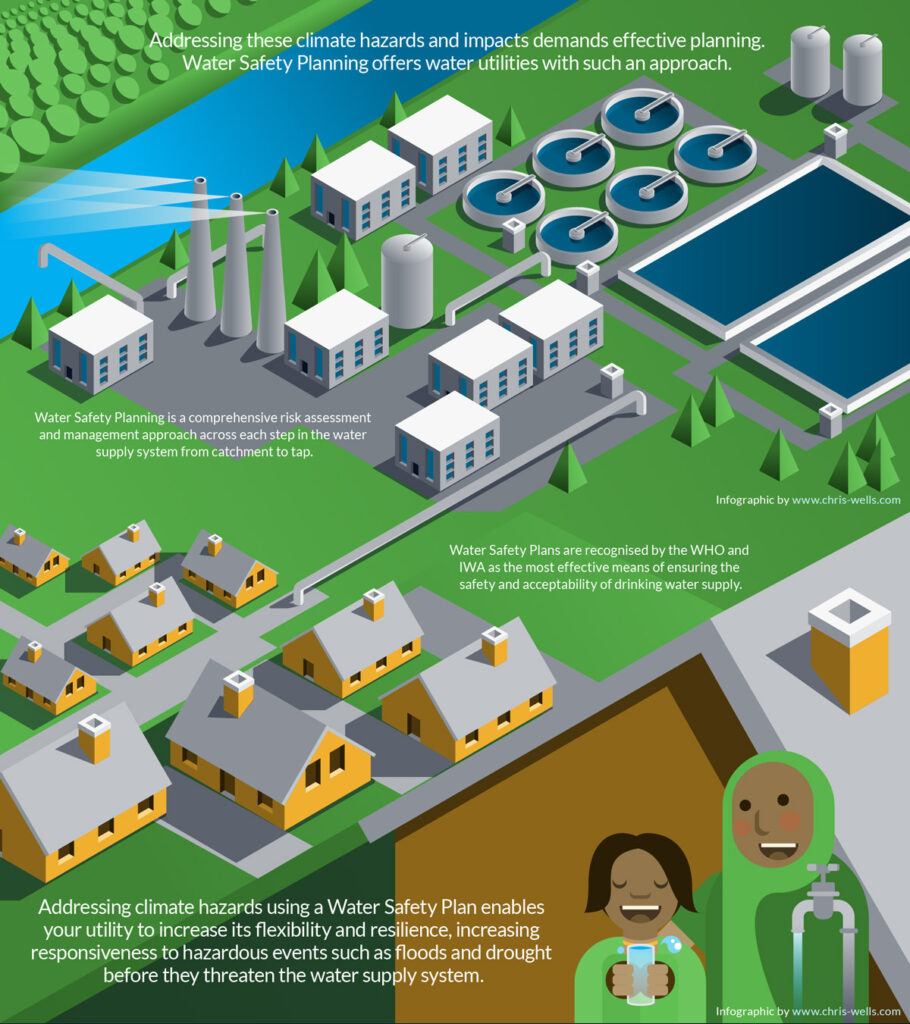Building resilience through adaptation and carbon neutrality
Climate resilience is more than implementing the right technology or practice to assess and address risks of extreme events. It is an approach that should be part of a coherent and holistic strategy to ensure sustainable water resources and safe and secure water supply.
Resilience needs to be built and coordinated at the basin, city and utility level to ensure adaptation measures for water systems are effective and integrate with other urban services. What this means is that adaptation approaches need to consider carbon emissions and strive to be carbon neutral.
Planning and information tools
Climate change is altering weather and water patterns around the world; causing more frequent and damaging floods and/or water shortages leading to droughts. With increasing climate variability and change, water users and practitioners are striving to become more resilient in their practices, need to prepare for such water-related risks by integrating scientifically sound climate information and risk assessments to adapt to changing demands and climatic conditions.
To plan, prepare and adapt to the impacts of climate change water professionals need tools that allow them to integrate climate information and risks into planning. Some examples of tools include:
1. Flood and Drought Management Portal
2. Climate Risk Informed Decision Analysis (CRIDA)
3. Climate Resilience Evaluation and Awareness Tool (CREAT)

Examples of climate adaptation tools
Flood and Drought Management Portal – The Flood and Drought Management Tools (FDMT) project developed the Portal which has technical applications to integrate better information on floods and droughts into planning from catchment to tap. Specific guidance tailored for water utilities on how to use the applications is available here. And an can be used to get an overview.
Climate Risk Informed Decision Analysis (CRIDA) – CRIDA provides stepwise planning guidance for water resources planners, managers, and engineers to implement robust water management under conditions of deep uncertainty
Climate Resilience Evaluation and Awareness Tool (CREAT) – CREAT is a software tool from the US EPA that assists drinking water and wastewater utility owners and operators in understanding potential climate change threats. The tool also aids in assessing the related risks at their individual utilities. The software identifies threats based on regional differences in climate change projections; it then assists utilities in designing adaptation plans based on the assessment.
Climate resilient water safety planning
Managing all aspects of the water supply system from water source to treatment to distribution, even components where the utility has no control, can be through Water Safety Planning (WSP), a comprehensive risk assessment and risk management approach that encompasses all steps and stakeholders of the water supply system from catchment to consumer.
WSPs are cited by World Health Organisation (WHO) as an effective means of consistently ensuring the safety and acceptability of a drinking-water supply. Learn more about WSP at the WSPortal.
WSPs are an entry point to prompt utilities to consider climate information and adaptation measures that can be put in place in their planning procedures. Guidance (Climate Resilient Water Safety Plans) is available from WHO on how climate considerations can be integrated into water safety planning to provide greater resilience to the current and predicted impacts of climate change and variability on water supplies.
IWA, through support from the OPEC Fund for International Development, is addressing how utilities through WSP can better prepare, respond and adapt to extreme weather events.

Nature Based Solutions supporting adaptation
Nature Based Solutions supporting adaptationInvestment in nature-based solutions is increasingly seen as a way to adapt to climate (and other) impacts in both urban and rural settings such as floods, shortages in supplies, increased demand and degradation of water quality.
An example is from the Danish water utility Skanderborg Forsyning where climate change projects are an opportunity to adapt using nature to deal with increased rainfalls and prevent the flooding of urban areas. Explore more applications of nature base solutions by water utilities in a publication of utility case studies intended to shed light on the opportunities and challenges to incorporate nature-based solutions into water management.